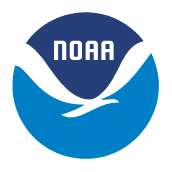GSL creates new visualizations of Urban Heat Islands
GSL has partnered with the NOAA Climate Program Office, the NOAA Office of Education the U.S. State Department, NOAA Environmental Visualization Lab, and Meta (Facebook) to bring Urban Heat Island (UHI) (definition at bottom) data to the 27th Conference of the Parties of the UNFCCC (COP 27) taking place in Egypt during November. Meta will be providing virtual reality headsets for the U.S. pavilion which will include a GSL-developed “experience” highlighting UHI data for Washington DC. The data are classified by natural breaks to clearly illustrate the variation between warmer (red) and cooler (blue) areas across the map. Large swaths of asphalt in commercial areas can spill concentrated heat into surrounding areas. Residential areas with a high percent canopy cover seem to retain less heat throughout the day.
 GSL has partnered with the NOAA Climate Program Office, the NOAA Office of Education the U.S. State Department, NOAA Environmental Visualization Lab, and Meta (Facebook) to bring Urban Heat Island (UHI) (definition at bottom) data to the 27th Conference of the Parties of the UNFCCC (COP 27) taking place in Egypt during November. Meta will be providing virtual reality headsets for the U.S. pavilion which will include a GSL-developed “experience” highlighting UHI data for Washington DC. The data are classified by natural breaks to clearly illustrate the variation between warmer (red) and cooler (blue) areas across the map. Large swaths of asphalt in commercial areas can spill concentrated heat into surrounding areas. Residential areas with a high percent canopy cover seem to retain less heat throughout the day.
GSL has partnered with the NOAA Climate Program Office, the NOAA Office of Education the U.S. State Department, NOAA Environmental Visualization Lab, and Meta (Facebook) to bring Urban Heat Island (UHI) (definition at bottom) data to the 27th Conference of the Parties of the UNFCCC (COP 27) taking place in Egypt during November. Meta will be providing virtual reality headsets for the U.S. pavilion which will include a GSL-developed “experience” highlighting UHI data for Washington DC. The data are classified by natural breaks to clearly illustrate the variation between warmer (red) and cooler (blue) areas across the map. Large swaths of asphalt in commercial areas can spill concentrated heat into surrounding areas. Residential areas with a high percent canopy cover seem to retain less heat throughout the day.
In Boulder, CO, after months of collaboration and coordination, local organizers and volunteers collected thousands of temperature and humidity data points in the morning, afternoon, and evening of a long, hot campaign day on July 22nd, 2022. The resulting data provide snapshots in time of how urban heat varies across neighborhoods and how local landscape features affect temperature and humidity. The image below shows the evening UHI data for Boulder along with 3D buildings and the tree canopy from Boulder’s open data portal.
*An urban heat island (UHI) is an urban or metropolitan area that is significantly warmer than its surrounding rural areas due to human activities. The temperature difference is usually larger at night than during the day, and is most apparent when winds are weak. The main cause of the UHI effect is from the modification of land surfaces. As a population center grows, it tends to expand its area and increase its average temperature.

Urban heat island data from Boulder, Colorado.
Our Mission
Lead research and directed development through the transition of environmental data, models, products, tools, and services to support commerce, protect life and property, and promote a scientifically literate public.
Research Areas
Organizational Excellence, Earth System Prediction, Advanced Technologies, and Decision Support are the foundation to achieving the GSL Grand Challenge: Deliver actionable global storm-scale prediction and environmental information through advanced technologies to serve society.
Global Systems Laboratory

